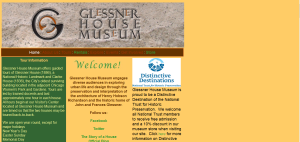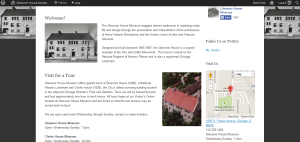Recently our new media class was split into groups and asked to try our hand at creating a new website for the Glessner House Museum, a historic home here in Chicago. If you visit the Glessner House website, it’s fairly obvious why the site needs to be updated. It seems clunky and dated, like it hasn’t been updated in 10 years. In reality, however, the content of the page is well-maintained and updated frequently. But the appearance turns you off. I think most active internet users would agree that a good website can turn you on to a new product or organization while a bad website can completely turn you off of something you were initially interested in. I have never visited the Glessner House, but if I was exploring options for museums in Chicago, a visit to this website would lead me to cross the Glessner House off my list.
Of course, the Glessner House is a relatively small organization. They do not have the funds to operate a dynamic website the way better funded organizations like The Field Museum can. While a great website can be expensive and time-consuming to maintain, it doesn’t have to be. With the advances in free and low-cost site hosting platforms, an attractive website can be a lot easier to create than some might think. Sites like wordpress.com (where this blog is hosted, for instance) provide you with templates and themes to create a website without having knowledge of HTML.
WordPress is what my group chose to use for our version of the Glessner House site. Overall, I was happy with our final product. Our version of the site has a sleeker look to it, and it breaks up much of the content into more manageable chunks than the original site. Like any project, however, there were some things that went really well and problems we would hope to avoid in the future, some of which were unique to the fact that this was a collaborative project on a digital level.
One advantage to working on a digital project, especially over spring break, is that we were able to redesign the site working entirely remotely. Half of our group was out of town for the week, a traditional project would have been a major hassle to coordinate in those circumstances, but a digital project proved incredibly easy. A short meeting after the project was assigned allowed us to decide on a platform to create our site with and to divide the workload. After that, it was simply a matter of each person working on his or her individual portion of the site and communicating about our progress via email. Unlike splitting up the work for a traditional project, we were all able to monitor what changes looked like in real time and in the context of the final product. This made it simple to suggest modifications to each other without having to wait until a section was completed and sent to the group for revision.
We chose to use WordPress for our site because everyone in our group was familiar with the way this platform works and how to create content. While I like WordPress, it might have been interesting to explore other sites. Some groups, for instance, made fantastic looking new sites using wix.com. Unfortunately, no one in our group had ever used this platform before. With varying levels of digital experience under our belts, the thought of everyone learning to use an entirely new site seemed daunting. If any one of us had been redesigning the site by ourselves, I think it would have been much easier to explore a new hosting platform and experiment with that. Working together, but remotely, we decided to use what we knew, rather than make things more difficult and attempt to learn the intricacies of a completely new site.
But even using a platform we all knew well, we ran into a few problems with our design. Originally, we had hoped to create a slide show display of photographs for our homepage. We chose a theme (prepackaged templates that allow you to choose the “look” of your wordpress site) which appeared to have this capability, but when we explored our appearance options we could not find a way to create the slide show affect. WordPress allows you to upgrade your site theme for more customization if you pay a set fee, so perhaps if we had been in the position to pay for an upgrade we would have been able to create the slide show we desired.
Overall, however, our redesigned site was a success. Our group was able to work efficiently despite being in different states because we all understood how to use the platform and because we were all able to see the final product in real time whenever an edit was made. While our own varied digital knowledge and our inability to work together in person meant that we were unable to explore different possibilities, we were still able to create a site that is both easily navigable and visually appealing.

